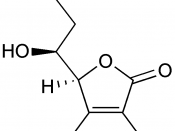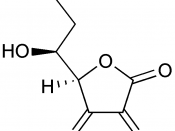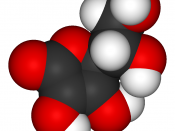Date: 25 Nov, 2004
Objective:
1. To standardize sodium thiosulphate for titration use.
2. To find out the concentration of Vitamin C in the tablet.
Theory:
This experiment involves titration of redox reaction. Redox reaction means reduction and oxidation. In which oxidizing agent and reducing agent are mixed and oxidize/reduce each other. One losses electron(s) and increase in oxidation number when is oxidized, and vice versa.
In order to find out concentration of the ascorbic acid in the tablet, a redox reaction of it with iodine was done. While iodine is an oxidizing agent and ascorbic acid is a reducing agent. The reaction forms dehydroascorbic acid and iodide.
Ascorbic acid + I2 -> dehydroascorbic acid + 2 H+ + 2 I-
However, Iodine does not dissolve in water very well. In this case, standard solution of potassium iodate(V) is used to produce aqueous iodine. Excess potassium iodide and dilute sulphuric acid is added to react with potassium iodate.
KIO3 + 5 KI + 3 H2SO4 -> 3 I2 + 3 H2O + 3 K2SO4
Excess potassium iodide also helps dissolving iodine produced.
I-(aq) + I2(s) I3-(aq)
Iodine does not react with ascorbic acid too quickly, that is why they cannot be titrated directly. We use excess iodine solution to react with limited vitamin C. Iodine left is then titrated with sodium thiosulphate, a reducing agent, thus number of mole of iodine reacted with vitamin C can be found out. This technique is known as back titration.
Sodium thiosulphate absorbs water in the atmosphere with time. It's concentration decreases with time as volume of water increases. In this case, standization of sodium thiosulphate is needed. Sodium thiosulphate is titrated with standard iodine solution, and the concentration of it can be found out.
2 Na2S2O3 + I2 -> Na2S4O6 + 2 NaI...



I don't know why all arrows has turned into -&gt
if you see a "-&gt" it is an right arrow, just to remind you that..
i'll try to fix it.. -_-
0 out of 0 people found this comment useful.